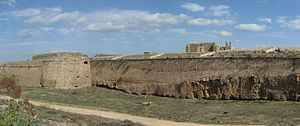Type City wall | Condition Intact | |
 | ||
The fortifications of Famagusta are a series of defensive walls and other fortifications which surround the city of Famagusta in Northern Cyprus. The walls were built by the Venetians in the 15th century, and withstood an 11-month siege before the city capitulated to the Ottoman Empire in August 1571.
Contents
Medieval period
In the 13th century, Famagusta's harbour was defended by a tower, and it is possible that some form of fortification existed earlier. In the 14th century, the Lusignans built the Othello Castle to defend both the harbour and the town. Famagusta fell to the Genoese in 1373, and in 1489 it was taken over by the Republic of Venice along with the rest of Cyprus.
Venetian rule
While Famagusta was under Venetian rule, the city was essentially a military base. The Othello Castle was modernized, and fortifications surrounding the entire city began to be built. The fortifications were designed by a number of military engineers, including Michele Sanmicheli and his nephew Giovanni Girolamo Sammichele. The latter arrived in Famagusta in around 1550, and he designed the Martinengo Bastion, which served as a prototype for various other fortifications in Europe and America. He died in Famagusta in 1559, while the fortifications were still under construction.
The Fourth Ottoman–Venetian War broke out in 1570, when an Ottoman force invaded Cyprus and took control of most of the island including Nicosia within a few months. On 15 September, Ottomans surrounded Famagusta, which was the last Venetian stronghold on the island, and began the Siege of Famagusta. The city held out until August 1571, when the Venetians asked for terms of surrender. Although terms were agreed and the inhabitants began to evacuate the city, at the surrender ceremony Lala Mustafa Pasha learned that some Muslim prisoners had been killed and he had the Venetian commander Marco Antonio Bragadin mutilated and flayed alive, and the remaining Christians in the city were massacred.
Ottoman rule to present day
The Ottomans repaired the damaged parts of the walls, but did not make any major alterations. The city began to expand outside its walls in the late Ottoman period, and this increased after Cyprus fell under British rule.
Although many buildings within the old city of Famagusta is in a state of disrepair, the fortifications are still in relatively good condition.
Layout
The fortifications of Famagusta consist of an enceinte which is surrounded by a rock-hewn ditch on the landward side, and the harbour on the seaward side. Like the fortifications of Rhodes, which were built by the Knights Hospitaller between the 14th and 16th centuries, the walls of Famagusta show the transition between medieval fortification and the bastioned fortifications of the early modern period.
